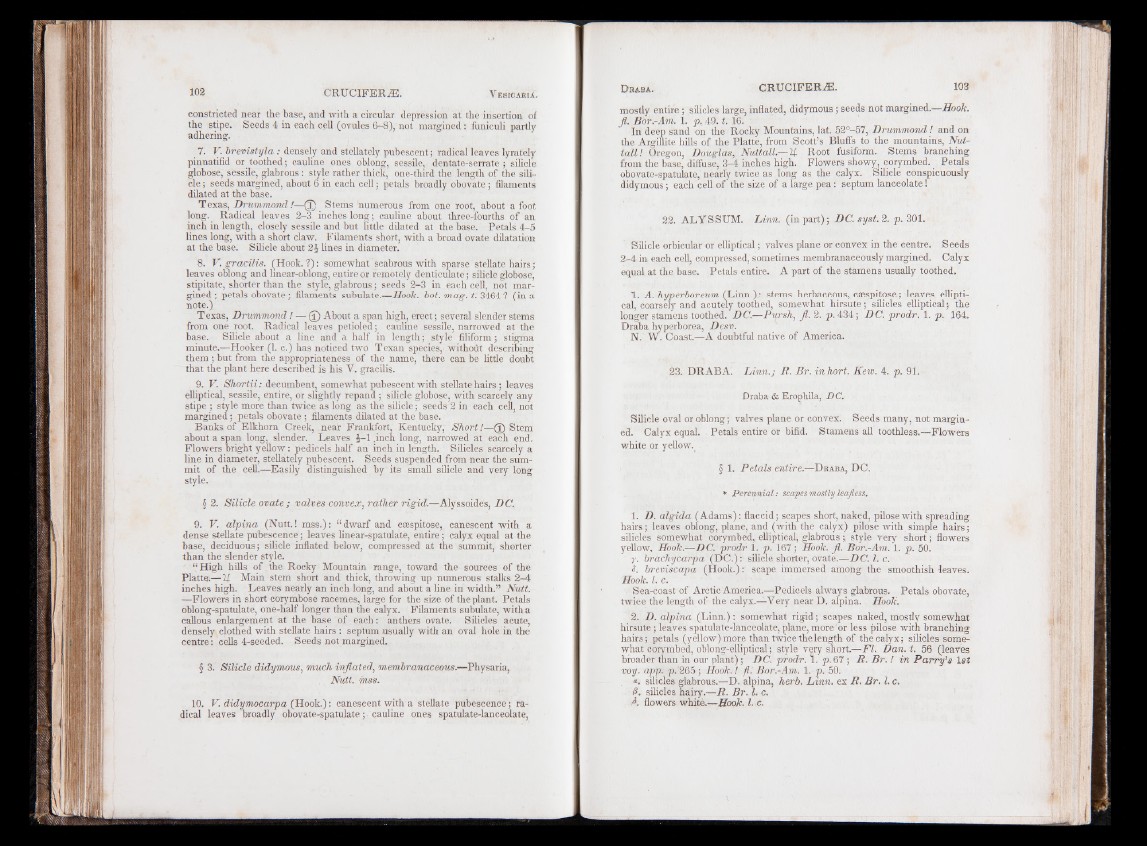
102 CRUCIFERiE. V ESICARIA.
constricted near the base, and with a circular depression at the insertion of
the stipe. Seeds 4 in each cell (ovules 6-8), not margined: funiculi partly
adhering.
7. V. brevistyla : densely and stellately pubescent; radical leaves lyrately
pinnatifid or toothed; cauline ones oblong, sessile, dentate-serrate; silicle
globose, sessile, glabrous : style rather thick, one-third the length of the silicle
; seeds margined, about 6 in each cell; petals broadly obovate; filaments
dilated at the base.
Texas, Drummond!—(J) Stems 'numerous from one root, about afoot
long. Radical leaves 2-3 inches long; cauline about three-fourths of an
inch in length, closely sessile and but little dilated at the base. Petals 4-5
lines long, with a short claw. Filaments short, with a broad ovate dilatation
at the base. Silicle about 2J fines in diameter.
8. V. gracilis. (Hook.?): somewhat scabrous with sparse stellate hairs;
leaves oblong and linear-oblong, entire or remotely denticulate; silicle globose,
stipitate, shorter than the style, glabrous; seeds 2-3 in each cell, not margined
; petals obovate; filaments subulate —Hook. hot. mag. t. 3464? (in a
note.)
Texas, Drummond ! — @ About a span high, erect; several slender stems
from one root. Radical leaves petioled; cauline sessile, narrowed at the
base. Silicle about a fine and a half in length; style filiform; stigma
minute.—Hooker (1. c.) has noticed two Texan species,' without describing
them; but from the appropriateness of the name, there can be little doubt
"that the plant here describedis his V. gracilis.
9. V. Shortii: decumbent, somewhat pubescent with stellate hairs ; leaves
elliptical, sessile, entire, or slightly repand ; silicle globose, with scarcely any
stipe ; style more than twice as long as the silicle; seeds 2 in each cell, not
margined; petals obovate ; filaments dilated at the base.
Banks of Elkhorn Creek, near Frankfort, Kentucky, Short!—(T) Stem
about a span long, slender. Leaves J - l .inch long, narrowed at each end.
Flowers bright yellow: pedicels half an inch in length. Silicles scarcely a
line in diameter, stellately pubescent. Seeds suspended from near the summit
of the cell.—Easily distinguished by its small silicle and very long
style.
§ 2. Silicle ovate ; valves convex, rather rigid.—Alyssoides, DC.
9. V. alpina (Nutt.! mss.): “ dwarf and caespitose, canescent with a
dense stellate pubescence; leaves linear-spatulate, entire; calyx equal at the
base, deciduous; silicle inflated below, compressed at the summit, shorter
than the slender style.
" “High hills of the Rocky Mountain range, toward the sources of the
Platt®—If Main stem short and thick, throwing up numerous stalks 2-4
inches high. Leaves nearly an inch long, and about a fine in width.” Nutt.
—Flowers in short corymbose racemes, large for the size of the plant. Petals
oblong-spatulate, one-half longer than the calyx. Filaments subulate, with a
callous enlargement at the base of each: anthers ovate. Silicles acute,
densely clothed with stellate hairs : septum usually with an oval hole in the
centre: cells 4-seeded. Seeds not margined.
§ 3. Silicle didymous, much inflated, membranaceous.—Physaria,
Nutt. mss.
10. V. didymocarpa (Hook.): canescent with a stellate pubescence; radical
leaves broadly ohovate-spatulate; cauline ones spatulate-lanceolate,
Drab a. CRUCIFERiE. 103
mostly entire; silicles large, inflated, didymous; seeds not margined.—Hook,
fl. Bor.-Am. 1. p, 49. t. 16. ‘
In deep sand on the Rocky Mountains, lat. 52°-57, Drummond /• and on
the Argillite hills of the Platte, from Scott’s Bluffs to the mountains, Nut-
ta ll! Oregon, Douglas, Nuttall.—U Root fusiform. Stems branching
from the base, diffuse, 3-4 inches high. Flowers showy, corymbed. Petals
obovate-spatulate, nearly twice as long as the calyx. Silicle conspicuously
didymous; each cell of the size of a large pea: septum lanceolate!
22. ALYSSUM. Linn, (in part); DC. syst. 2. p. 301.
Silicle orbicular or elliptical; valves plane or convex in the centre. Seeds
2-4 in each cell, compressed, sometimes membranaceously margined. Calyx
equal at the base. Petals entire. A part of the stamens usually toothed.
1. A. hyperboreum (Linn.),: stems herbaceous, csespitose; leaves elliptical,
coarsely and acutely toothed, sbmewhat hirsute; silicles elliptical; the
longer stamens toothed. DC.—Pursh, fl. 2. p. 434; DC. prodr. 1. p. 164.
Draba hyperborea, Desv.
N. W. Coast.—A doubtful native of America.
23. DRABA. Linn.; R. Br. inhort. Kew. 4. p. 91.
Draba & Erophila, DC.
Silicle oval or oblong; valves plane or convex. Seeds many, not margined.
Calyx equal. Petals entire or bifid. Stamens all toothless.—Flowers
white or yellow.^
§ 1. Petals entire.—Draba, DC.
* Perennial: scapes mostly leafless.
1. D. algida (Adams): flaccid; scapes short, naked, pilose with spreading
hairs; leaves oblong, plane, and (with the calyx) pilose with simple hairs;
silicles somewhat corymbed, elliptical, glabrous;, style very short; flowers
yellow. Hookfl*-DC. prodr 1. p. 167; Hook. fl. Bor.-Am. 1. p. 50.
y. brachycarpa (DC.): silicle shorter, ovate.—DC. 1. c.
S. breviscapa (Hook.): scape immersed among the smoothish leaves.
Hook. 1. c.
. Sea-coast of Arctic America.—Pedicels always glabrous. Petals obovate,
twice the length of the calyx.—Very near D. alpina. Hook.
2. D. alpina (Linn.): somewhat rigid; scapes naked, mostly somewhat
hirsute; leaves spatulate-lanceolate, plane, more‘or less pilose with branching
hairs; petals (yellow) more than twice the length of the calyx; silicles somewhat
corymbed, oblong-elliptical; style very short.—Fl. Dan. t. 56 (leaves
broader than in our plant); DC. prodr. 1. p. 67 ; R. Br. ! in P a rry ’s 1st
voy. app. p. 265 ; Hook.! fl. Bor.-Am. 1. p. 50.
a. silicles glabrous.—D. alpina, herb. Linn, ex R. Br. l.c.
0. silicles hairy.—R. Br. 1. c.
A flowers white.—Hook. l. c.